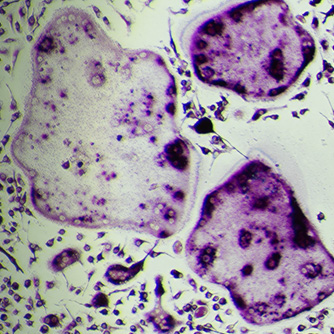Many of the simple pleasures of daily life, like eating, talking and smiling, are dependent on good dental health. As shown in Figure1, within the mandible and maxilla, teeth are supported by the periodontal tissue, which consists of not only the gums surrounding the teeth, but also the alveolar bone, periodontal ligament and cementum underneath.

Gum disease is caused by bacteria in the mouth and damages the periodontal tissue, causing teeth to loosen and sometimes leading to tooth loss. In Japan, gum disease is something of a national affliction; it affects approximately 70% of adults*1 and is the single greatest reason for tooth loss.*2
*12016 Odontopathy Survey, ages 30–69 (proportion of patients with abnormal findings related to the gums), Ministry of Health, Labour and Welfare
*2Research Report on the Causes of Loss of Permanent Teeth (2018), 8020 Promotion Foundation
Recent research has revealed that the destruction of periodontal tissue is caused not by periodontal pathogens, but rather by the excessive response of the immune system, which normally protects against infection. To prevent gum disease, Lion has advanced the development of “host care” technologies, focusing not just on eliminating periodontal pathogens, but on the body’s immune response and periodontal tissue. One part of such efforts is our research into medicated ingredients that may have an impact on the alveolar bone.
Even in adulthood, our bones are not static. Rather, the bones undergo ongoing metabolic change throughout our lives, as old bone is destroyed (resorbed), and new bone is formed. As shown in Figure 2, in healthy periodontal tissue, bone resorption and formation are in balance, keeping the amount of alveolar bone steady. However, with the progression of gum disease, inflammation causes increased resorption, upsetting that balance. As a result, the amount of alveolar bone decreases, ultimately leading to the loss of teeth.

Bone resorption is performed by cells called osteoclasts. Osteoclasts are multinucleated giant cells formed through differentiation from monocyte-macrophage lineage precursor cells, a type of immunocompetent cell. Lion’s researchers suggested that by suppressing the differentiation of osteoclasts, it might be possible to prevent the loss of alveolar bone due to gum disease. Investigating ingredients that could be used in toothpastes (classified as a quasi-drug in Japan) led them to turn their attention to phellodendron bark extract.
Phellodendron bark extract comes from Phellodendron amurense, a species of tree in the Rutaceae family, which also includes the genus Citrus. Lion received regulatory approval to use phellodendron bark extract as an active ingredient for periodontal disease prevention in light of its anti-inflammatory and gum-tightening effects. In recent years, research has found that berberine, a primary component of phellodendron bark extract, has a suppressant effect on osteoclast differentiation. Lion’s researchers therefore hypothesized that phellodendron bark extract should have a similar effect and conducted experiments to test this hypothesis.
The effect of phellodendron bark extract on osteoclast differentiation was examined in osteoclast precursor cells. Cells were cultured with an osteoclastogenic stimulus, prompting them to differentiate into osteoclasts in the presence of either phellodendron bark extract, berberine hydrochloride (a primary component of the extract), or just the solvent (as a vehicle control). The results of the experiments are shown in Figure 3. In the control group, to which only the solvent was applied, the formation of multinucleated cells can be observed (indicated by red arrows in the photos). In the groups dosed with phellodendron bark extract or berberine hydrochloride, however, osteoclast differentiation was suppressed, and the number of osteoclasts formed was found to be significantly lower. This research demonstrates that phellodendron bark extract suppresses the formation of osteoclasts involved in alveolar bone resorption, suggesting the possibility of a new approach to preventing gum disease.

Lion is applying these cutting-edge insights to product development, using them to create new gum disease prevention products that enable care for all periodontal tissue, including the alveolar bone.

Developing Pre-Caries Detection Technologies

Gum Disease Prevention Technology Development Focused on the Periodontal Tissue
Related Information